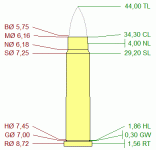A little history lesson….
Maybe some of you 22 Jet guys should look into bullet swaging?
Before the 22 Jet, a few guys like Jim Harvey and Kent Bellah were building custom centerfire revolvers using the S&W model 17. The cartridge eventually settled upon was the Harvey Kay-Chuk. It is a shortened and blown-out 22 Hornet. (See attached image)
Arguably, this was a better cartridge than the Jet as the straight case was not prone to the set-back issues that the S&W cartridge has often suffered.
But, I digress…
In the course of their experiments, they quickly discovered the need for a jacketed .222” bullet. I think a company named “Sisk” made .222” bullets for them. But, they also fulfilled their needs by swaging their own. They managed to get a die set into production to swage bullets using heavy duty “O” frame presses such as the RCBS A2, Rockchucker, or the CH Champion, etc.
I believe Jim Harvey was affiliated with this venture, and I recall that the brand name for the die sets was “Sportflite”.
Jim Harvey also pioneered the use of swaged-on Zinc washers that acted as gas checks.
I had a .44 cal set of his swaging dies that let me swage wadcutters, semi-wadcutters, and roundnose bullets, either with a half-jacket or the Zinc washer base. You could also adjust the dies to make bullets weighing anywhere from 120 to 275 grains, or so.
They actually worked pretty well. However, getting the half jackets and zinc bases became a real problem.
Best results are obtained with the zinc base bullets by a conditioning process known as “sherardizing”. Basically, after a number of shots, the zinc bonds with the steel in your barrel and forms a thin protective layer that resists fouling.
But, again, I digress…
They offered similar die sets for .38/357, 30 Carbine, and, pertinent to our discussion, .222” for 22 Jet or the Harvey Kay-Chuk.
The nice thing about the .22 cal swage die sets is that they were often intended to use fired .22 LR or Short rimfire cases as the jackets! (I think the LR cases were for heavier bullets.)
But, Jim Harvey recommended his swaged lead bullets with the zinc base. They were capable of impressive velocities, not to mention dramatic expansion, at less pressure than similar loads using conventional jacketed bullets.
His trade name for the bullets was “Prot-X-Bore”.
Today, there are a few guys who make custom order swage die sets. And, I think Corbin still makes their dies as well.
And, CH used to make .22 swage die sets.
Entry cost is about $300 up to, perhaps, $1000 for the Corbin dies.
There were also bullet molds (made by Ideal/Lyman, I recall) that used the Zinc washers. I never tried this, as I heard it was a bit if a pain fitting the Zinc bases, one at a time, in the single cavity molds while still casting fast enough to keep the mold hot.
Might be worth exploring.
If nothing else, this was an important historical aspect that helps to enrich our understanding of the .22 Jet and it’s development.
(Hint: try online searches of some of the names and terms I have mentioned here!)



